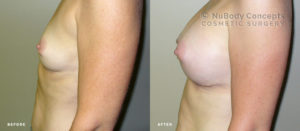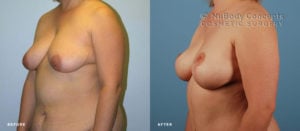
Medically reviewed by Dr. John Rosdeutscher – Written by Sine Thieme
A breast lift (mastopexy) and a breast augmentation (with breast implants) are two very different plastic surgeries that seek to amend the shape, size, and appearance of the breasts. A breast lift is used to reshape breasts that have lost firmness and sag or droop. A breast augmentation places implants above or below the chest muscles to make the breasts appear larger and firmer. Although both breast augmentation and breast lift change the look and size of the breasts, they each have their own unique results and benefits.
You may also hear that these procedures are often performed together. This is fully dependent on your body and your individual aesthetic goals (sometimes your surgeon may recommend two separate surgeries).
In this article we will address breast augmentation vs breast lift procedures and how they differ, the benefits of each, and how they may be combined.
Which is Better: Breast Lift or Breast Implants?
There is no sure fire way to determine which plastic surgery is better. Each breast surgery offers its own unique set of benefits, results, and even disadvantages. It is important to understand that a breast augmentation with implants focuses more on increasing the size and shape of the breasts and is not a cure for sagging breasts. In a similar way, an breast lift focuses primarily on the position of the breasts and often in fact reduces the size of your bust by a cup size.
When these cosmetic surgeries are combined, it is to restore a more youthful position of the nipples and bust while also increasing volume via implants. Having an augmentation/pexy will provide greater upper breast fullness along with better positioning and symmetry of the nipples, areolas, and bust itself.
What to Consider Before Making a Decision
Before making a decision on whether an augmentation or breast lift is right is right for you, it may be important to consider the following:
Nipple positioning
If you notice that your nipples point downward or sit below the inframammary fold, you may be more interested in a breast lift. Sagging tissues and drooping breasts can cause a change in the positions of, stretch, and even enlarge the nipples and areolas. Women who have lost volume in their upper breasts often experience heaviness in the lower pole, which can cause the nipple to sag. Breast lifts are best for lifting the breasts to a more optimal position, repositioning the nipple/areola, as well as reshaping the nipple and areola if necessary.
Volume
Breast volume often refers to the fullness and roundness of the breast. In some cases, weight loss, pregnancy, and breastfeeding can cause the breasts to be fuller at a previous time and deflate over time. In some cases, breast implants can be a great way to restore deflated breasts while also restoring their natural shape and appearance. This may be combined with a breast lift if any breast skin laxity needs to be addressed.
Breast size
Breast augmentations are the most common cosmetic plastic surgery procedures performed every year. The reason being: many women are unhappy with their breast size for a number of reasons. Some women want to enlarge their breasts as they are unhappy with the size, some women notice asymmetry and want to have it corrected, while others desire a breast reduction. A consultation with your local plastic surgeons will help you understand all of your options – breast implant options and sizes, how a breast lift can help fix asymmetry, and give you a better idea on how you will look after your procedure.



Breast Augmentation via Breast Implants: What to Know
Are you wanting larger breasts or restored volume to breasts that have deflated from weight loss or pregnancy? If you answer yes, then a breast augmentation via implants may be the best breast surgery for you. When considering breast implants vs breast lift, there are three major areas that must be considered: incision placement, implant size & shape, and the type of implant.
Incision and implant placement: With breast augmentation surgery, there are three common incision sites: under the inframammary fold (the breast crease), trans-axillary (in or around the armpit), and/or periareolar (around the areola/nipple). Each incision has its own benefits and disadvantages. Talk with your plastic surgeon about which incision type is best for you and the advantages and disadvantages of that recommendation.
Implant size and shape: There are many options when it comes to the size and shape of your implants. Your plastic surgeon will take into account your chest wall shape, body form, lifestyle, and your natural foundation as well as your individual aesthetic goals before making any recommendations. A board-certified plastic surgeon will be able to properly address outcomes, results, and which size, type, and placement would best address your aesthetic concerns. It is often recommended to not go above two bra cup sizes so as to not overwhelm the breasts’ appearance, diameter, and/or width.
Implant types: The materials used for a patient’s breast augmentation will depend on desired results, individual preference, and the body type of the patient. At NuBody Concepts we use saline and silicone implants as well as variations of these materials – form-stable and round implants. Read more here to learn more about breast implants at NuBody Concepts.
Breast Lift: What to Expect
Breasts may lose significant volume over time with age, due to fluctuations in weight, or if a woman has birthed children. Severe drooping of the breasts is called breast ptosis. A breast lift can help treat moderate to severe ptosis by volumetrically reconstructing the breasts.
In order to determine if you are a good candidate for a breast lift, you can perform what is called a pencil test at home. To do this, place a pencil as high as you can underneath your breast fold. If the pencil holds and does not fall, you show signs of drooping. If you notice your nipple falling below the pencil, you show signs of severe ptosis, and are likely a great candidate for a breast lift plastic surgery.
There are also several different types of breast lift techniques.
- Crescent Breast Lift: A crescent lift technique is only used for women who have a small amount of sagging to correct. The incision is carefully made halfway around the top half of the areola, above the nipple. This lift is typically only performed if a patient is having additional breast augmentation procedures (i.e. breast implants) – and even then it is not very common.
- Periareolar Breast Lift: the periareolar incision approach follows that natural shape of the patient’s breast and is often best for someone with large areolas and minimal breast drooping
- Vertical Lift: the vertical breast reduction incision technique has a similar path as the periareolar, but continues from the base of the areola to the breast crease. This allows for a greater lift for moderate drooping.
- Inverted T Lift: this is the most common approach as it is the most predictable and allows for the most lift to the breasts. It follows a similar incision pattern as the vertical lift, yet continues horizontally along the breast fold.
The best technique for you will be entirely dependent upon the amount of breast volume, tissue being removed, and the degree of ptosis you have.
Can I Get Breast Implants and a Breast lift?
Yes, both a breast lift and a breast augmentation can be performed alone or be combined into one procedure. In some cases, a breast augmentation and breast lift are performed during a mommy makeover. However, choosing to have a lift or augmentation years after your prior procedure shouldn’t be a problem. Talk with your surgeon about whether or not combining the procedures would be right for you.
Recovery and Results with Breast Lift
The recovery period from a breast lift is fairly similar to that of a breast augmentation. One of the primary differences is that your surgeon may place small tubes into your breasts after your surgery in order to drain any excess fluid. Often the pain is manageable, mild soreness and discomfort is often reported, and often lasts for only around a week after the surgery.
In some cases, dissolvable stitches are used so a follow up procedure is unneeded to remove stitches. However, it is always best to schedule a follow up for a nurse to check your surgical site for any signs of potential infection. Your doctor will likely recommend wearing a sports bra or other form of compression bra to give your bust support as it heals and to reduce swelling. Your surgeon may recommend pain medication to take during the first week of your recovery.
You should avoid strenuous physical activities for at least 4 to 6 weeks, but many women report returning back to their office job within a week post-op.
Recovery and Results with Breast Implants
The recovery period for breast implants lasts about 6 weeks. After the procedure you will likely experience dizziness from the anesthesia and mild pain and discomfort at the incision site. You will also be advised to wear a surgical bra (support bra) for a certain time (as recommended by your plastic surgeon) while you heal. Within the first week, you may begin returning to your daily activities. Again, it is advised that you refrain from strenuous activities for at least 6 weeks after your surgery.
Consult with A Board-Certified Plastic Surgeon
You can begin your breast enhancement journey with a consultation with our board-certified plastic surgeons in Nashville or Memphis, each with over 20 years of experience in this field. They will be a vital part of your team as you begin this life-changing cosmetic experience. You can view our before and after galleries here and learn more about our breast lift procedures on our blog.
We look forward to hearing from you!















